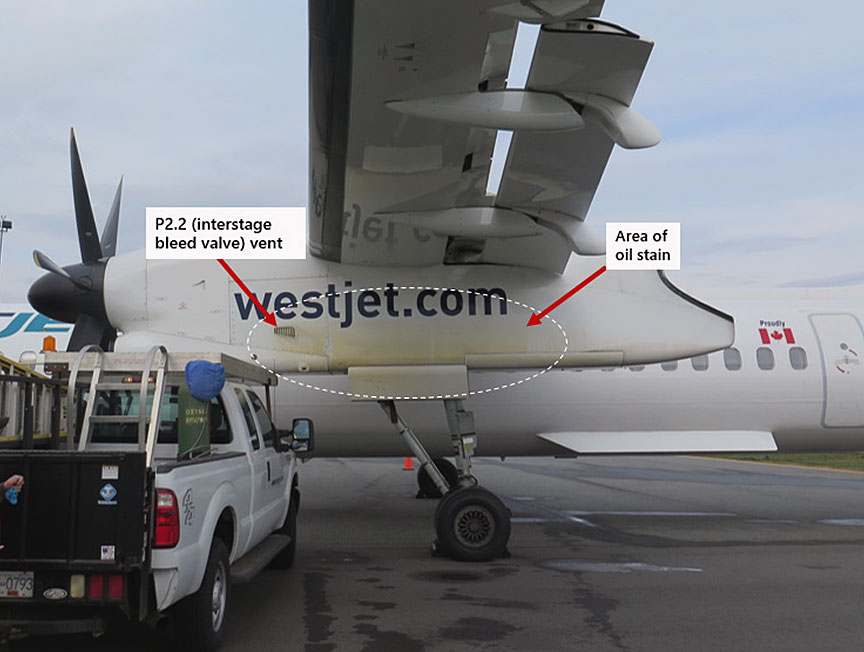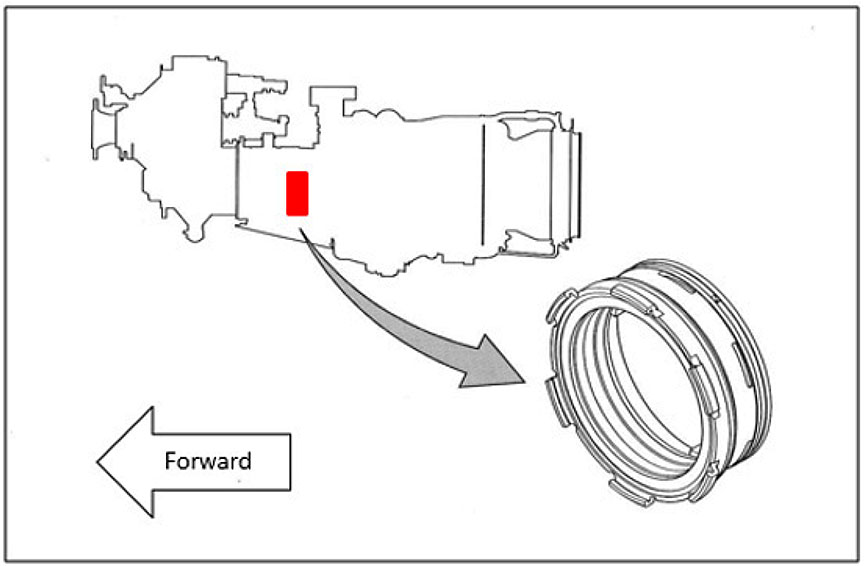In-flight emergency due to smoke in cockpit and cabin
WestJet Encore Ltd.
Bombardier DHC-8-402, C-GJEN
Nanaimo Airport, British Columbia
The Transportation Safety Board of Canada (TSB) investigated this occurrence for the purpose of advancing transportation safety. It is not the function of the Board to assign fault or determine civil or criminal liability. This report is not created for use in the context of legal, disciplinary or other proceedings. See Ownership and use of content. Masculine pronouns and position titles may be used to signify all genders to comply with the Canadian Transportation Accident Investigation and Safety Board Act (S.C. 1989, c. 3).
Factual information
History of the flight
The Bombardier DHC-8-402 (registration C-GJEN, serial number 4536), operated by WestJet Encore Ltd. as flight 3161, was on a daylight instrument flight rules (IFR) flight from Vancouver International Airport (CYVR), British Columbia, to Nanaimo Airport (CYCD), British Columbia, with 2 pilots, 2 cabin crew members, and 56 passengers on board. The aircraft departed CYVR at approximately 1219Footnote 1 with the first officer as the pilot flying and the captain as the pilot monitoring.
At about 1230, while at 2000 feet above sea level, in visual meteorological conditions, on approach to CYCD, the flight crew noticed smoke in the cockpit. Shortly afterward, a cabin attendant notified them that there was smoke in the cabin. The flight crew immediately followed the company's DHC-8-400 Quick Reference Handbook (QRH) "Fuselage Fire or Smoke" procedures, which included donning their oxygen masks, declaring an emergency with Air Traffic Services, and continuing the approach to CYCD.
At 1235, the aircraft landed on Runway 16 and came to a stop on the runway adjacent to Taxiway B, with ground emergency vehicles already positioned nearby. Some smoke was visible outside the aircraft near the left engine, but it dissipated quickly, and there was no sign of fire. No extinguishing agent was used by ground crews at the scene.
The passengers and cabin crew evacuated the aircraft onto the runway in 62 seconds. The pilots deplaned shortly afterward. There were no reported injuries. Runway 16/34 was closed for 1 hour while Nanaimo Airport staff and WestJet staff escorted the passengers and crew to the terminal, conducted a runway foreign-object check, and towed the aircraft onto the apron.
The outboard side of the left engine nacelle had a significant quantity of oil on it, originating primarily from the P2.2 (interstage bleed valve) vent in the engine cowl (Figure 1). Oil was also observed in the engine air-intake plenum and on the chin cowl immediately above the air intake.
Analysis
Cockpit voice and flight data recorders
As per regulations, the aircraft was equipped with a cockpit voice recorder and a flight data recorder, which were removed and sent to the TSB Engineering Laboratory. The data indicated that the crew had received no warnings or alarms (other than that of the lavatory smoke detector) before or after the smoke appeared inside the aircraft, and that both engines appeared to operate normally throughout the flight. The crew performed in accordance with the QRH and company standard operating procedures.
Aircraft information
Records indicated that C-GJEN was certified, equipped, and maintained in accordance with existing regulations and approved procedures. The aircraft, a DHC-8-402 (also called a Q400), was manufactured by Bombardier Inc. in 2016. It is a twin-engine, medium-range, turboprop airliner with 78 passenger seats and a cruise speed of about 360 knots. At December 2017, about 1242 Q400 aircraft had been delivered.
| Manufacturer | Bombardier Inc. |
| Type, model, and registration | DHC-8-402, Q400, C-GJEN |
| Year of manufacture | 2016 |
| Serial number | 4536 |
| Total airframe time | 3488 hours |
| Engine type (number of engines) | PW150A (2) |
| Maximum allowable take-off weight | 29 574 kg |
Findings
Engine teardown
The aircraft is powered by 2 Pratt & Whitney Canada (P&WC) PW150A turboprop engines, which also supply air for cabin pressurization. This engine model is used exclusively in Bombardier Q400 aircraft. C-GJEN's left engine (serial number PCE-FA1210) had been installed new on 30 June 2016 during the aircraft's initial construction.
At the time of the occurrence on 20 March 2018, the engine and airframe had accumulated approximately 3488 hours total time since new.
Following the occurrence, the engine was removed from the aircraft and shipped to P&WC in Montréal, Quebec, for teardown and inspection. The inspection revealed that a steel spring (wave washer) in the 2.5 bearing carbon seal had disintegrated, compromising the efficiency of the carbon seal. That deficiency had in turn allowed turbine oil to leak past the carbon seal and enter the compressor airstream and the cabin pressurization system. The 2.5 bearing is located at the forward end of the low-pressure compressor (Figure 2). As a result of previous 2.5 bearing carbon seal failures, P&WC issued Service Bulletin (SB) 35342 on 06 October 2016. Revision 1 of the SB was issued on 24 January 2018.
The original SB had called for modification of the bearing carbon seal (part number 3071831-01). The revised bulletin (SB 35342 R1) recommends that operators "[r]eplace the No. 2.5 bearing seal with one that has an increased minimum spring load to prevent potential spinning of the air/oil bearing seal ring."Footnote 2 The part number of the new bearing carbon seal is 3127372-01.
P&WC rated the SB's compliance urgency as Category 6,Footnote 3 under which it recommends that operators comply with the SB "when the subassembly (i.e. module, accessories, components, or build groups) is disassembled and access is available to the necessary part."Footnote 4
The occurrence engine was not due for overhaul and had not been disassembled for repair; therefore, the recommendation in the SB was not performed. No related airworthiness directive has been issued by Transport Canada.
P&WC has reported that, as of May 2018, the upgraded bearing carbon seal introduced via SB 35342 R1 has been installed in about 35% of the fleet. None of the new part number bearing carbon seals have failed to date.
Safety action
Preventive safety action
To mitigate the risk for operators that have not yet complied with SB 35342 R1, P&WC has developed a new oil analysis technology to detect chemical elements and alloys in the engine oil, and to analyze its concentration and particulate characteristics to determine the source (component) of the material.
P&WC reports that the technology provides improved precision and sensitivity compared to that of traditional oil debris analysis technology used to monitor the health of oil-wetted engine components such as bearings, carbon bearing seals, and gears. The company has also reported successful detection and identification of material generated by a deteriorating 2.5 bearing carbon seal in a PW150A engine 900 hours before the seal required replacement to prevent oil contamination of the compressor and cabin air.
The oil analysis technology program, which has been available to operators on a trial basis since 2016, is currently available to all operators. Following the occurrence, WestJet Encore Ltd. implemented P&WC's recommended oil analysis technology program on its Q400 fleet.
Summary
Incidents involving cabin air contamination by engine oil have been known to occur in turbine- and turboprop-powered aircraft. The engine manufacturer was aware of the source of the oil leak (the 2.5 bearing carbon seal), had designed a repair (installation of an upgraded seal), and had informed operators of the repair (via SB 35342 R1). Further, the engine manufacturer has made available, to operators who have not yet carried out the overhaul recommended in the SB, an oil analysis technology program for the detection of impending seal failures.
The aircraft crew responded appropriately and rapidly during the occurrence and were able to land and evacuate the aircraft with no injuries and no damage. Air Traffic Services and airport personnel also responded in a timely manner, which contributed to the positive outcome.
This concludes the TSB's limited-scope investigation into this occurrence. The Board authorized the release of this investigation report on . It was officially released on .

